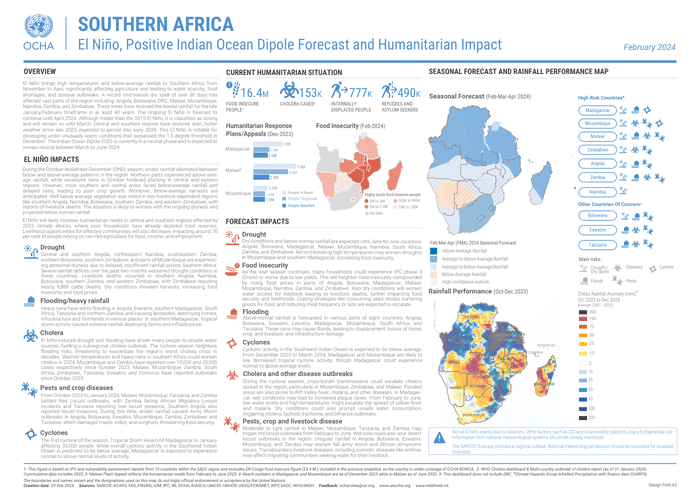Attachments
OVERVIEW
El Niño brings high temperatures and below-average rainfall to Southern Africa from November to April, significantly affecting agriculture and leading to water scarcity, food shortages, and disease outbreaks. A record mid-season dry spell of over 30 days has affected vast parts of the region including, Angola, Botswana, DRC, Malawi, Mozambique, Namibia, Zambia, and Zimbabwe. These areas have received the lowest rainfall for the late January/February timeframe in at least 40 years. The ongoing El Niño is forecast to continue until April 2024. Although milder than the 2015 El Niño, it is classified as strong and will remain so until March. Central and southern regions have endured drier, hotter weather since late 2023, expected to persist into early 2024. This El Niño is notable for developing under unusually warm conditions that surpassed the 1.5-degree threshold in December. The Indian Ocean Dipole (IOD) is currently in a neutral phase and is expected to remain neutral between March to June 2024.
EL NIÑO IMPACTS
During the October-November-December (OND) season, erratic rainfall alternated between below and above-average patterns in the region. Northern parts experienced above-average rainfall, while excessive rains in October hindered planting in central and eastern regions. However, most southern and central areas faced below-average rainfall and delayed rains, leading to poor crop growth. Moreover, below-average harvests are anticipated. Well below average vegetation was noted in key livestock-dependent regions like southern Angola, Namibia, Botswana, southern Zambia, and western Zimbabwe, with reports of livestock deaths. The situation is likely to worsen with the ongoing dryness and projected below normal rainfall.
El Niño will likely increase humanitarian needs in central and southern regions affected by 2023 climate shocks, where poor households have already depleted food reserves.
Livelihood opportunities for affected communities will also decrease, impacting around 70 per cent of people relying on rain-fed agriculture for food, income, and employment.
Drought
Central and southern Angola, northeastern Namibia, southeastern Zambia, northern Botswana, southern Zimbabwe, and parts of Mozambique are experiencing abnormal dryness due to delayed, insufficient rainfall across Southern Africa.
Severe rainfall deficits over the past two months worsened drought conditions in these countries. Livestock deaths occurred in southern Angola, Namibia,
Botswana, southern Zambia, and western Zimbabwe, with Zimbabwe reporting nearly 9,880 cattle deaths. Dry conditions threaten harvests, increasing food insecurity and food prices.
Flooding/heavy rainfall
Heavy rains have led to flooding in Angola, Eswatini, southern Madagascar, South Africa, Tanzania and northern Zambia, and causing landslides, destroying homes, infrastructure and farmlands in various places. In southern Madagascar, tropical storm activity caused extreme rainfall destroying farms and infrastructure.
Cholera
El Niño-induced drought and flooding have driven many people to unsafe water sources, fuelling a subregional cholera outbreak. The cyclone season heightens flooding risks, threatening to exacerbate the region’s worst cholera crisis in decades. Warmer temperatures and heavy rains in southern Africa could worsen cholera in 2024. Mozambique and Zambia have reported over 10,000 and 20,000 cases respectively since October 2023. Malawi, Mozambique, Zambia, South Africa, Zimbabwe, Tanzania, Eswatini, and Comoros have reported outbreaks since October 2023.
Pests and crop diseases
From October 2023 to January 2024, Malawi, Mozambique, Tanzania, and Zambia battled Red Locust outbreaks, with Zambia facing African Migratory Locust incidents and Tanzania reporting tree locust presence. Southern Angola also reported locust invasions. During this time, erratic rainfall caused Army Worm outbreaks in Angola, Botswana, Eswatini, Mozambique, Zambia, Zimbabwe and Tanzania, which damaged maize, millet, and sorghum, threatening food security.
Cyclones
The first cyclone of the season, Tropical Storm Alvaro hit Madagascar in January affecting 33,000 people. While overall cyclonic activity in the Southwest Indian Ocean is predicted to be below average, Madagascar is expected to experience normal to above normal levels of activity
FORECAST IMPACTS
Drought
Dry conditions and below-normal rainfall are expected until June for nine countries: Angola, Botswana, Madagascar, Malawi, Mozambique, Namibia, South Africa, Zambia, and Zimbabwe. Record-breaking high temperatures may worsen droughts in Mozambique and southern Madagascar, escalating food insecurity.
Food insecurity
As the lean season continues, many households could experience IPC phase 3 (Crisis) or worse due to low yields. This will heighten food insecurity compounded by rising food prices in parts of Angola, Botswana, Madagascar, Malawi, Mozambique, Namibia, Zambia, and Zimbabwe. Also dry conditions will worsen water access for livestock leading to livestock deaths, further impacting food security and livelihoods. Coping strategies like consuming seed stocks, bartering goods for food, and reducing meal frequency or size are expected to escalate.
Flooding
Above-normal rainfall is forecasted in various parts of eight countries: Angola, Botswana, Eswatini, Lesotho, Madagascar, Mozambique, South Africa, and Tanzania. These rains may cause floods, leading to displacement, losses of home, crop, and livestock, and infrastructure damage.
Cyclones
Cyclonic activity in the Southwest Indian Ocean is expected to be below average.
From December 2023 to March 2024, Madagascar and Mozambique are likely to see decreased tropical cyclone activity, though Madagascar could experience normal to above-average levels.
Cholera and other disease outbreaks
During the cyclone season, cross-border transmissions could escalate cholera spread in the region, particularly in Mozambique, Zimbabwe, and Malawi. Flooded areas are also prone to Rift Valley fever, malaria, and other diseases. In Madagascar, wet conditions may lead to increased plague cases. From February to June, low water levels and high temperatures might escalate the spread of yellow fever and malaria. Dry conditions could also prompt unsafe water consumption, triggering cholera, typhoid, trachoma, and bilharzia outbreaks
Pests, crop and livestock disease
Moderate to light rainfall in Malawi, Mozambique, Tanzania, and Zambia may trigger red locust outbreaks from February to June. Wet soils could also spur desert locust outbreaks in the region. Irregular rainfall in Angola, Botswana, Eswatini, Mozambique, and Zambia may worsen fall army worm and African armyworm issues. Transboundary livestock diseases, including zoonotic diseases like anthrax may affect migrating communities seeking water for their livestock.
Disclaimer
UN Office for the Coordination of Humanitarian Affairs
To learn more about OCHA’s activities, please visit https://www.unocha.org/.
Source link : https://reliefweb.int/report/madagascar/southern-africa-el-nino-positive-indian-ocean-dipole-forecast-and-humanitarian-impact-february-2024
Author :
Publish date : 2024-03-13 07:00:00
Copyright for syndicated content belongs to the linked Source.
